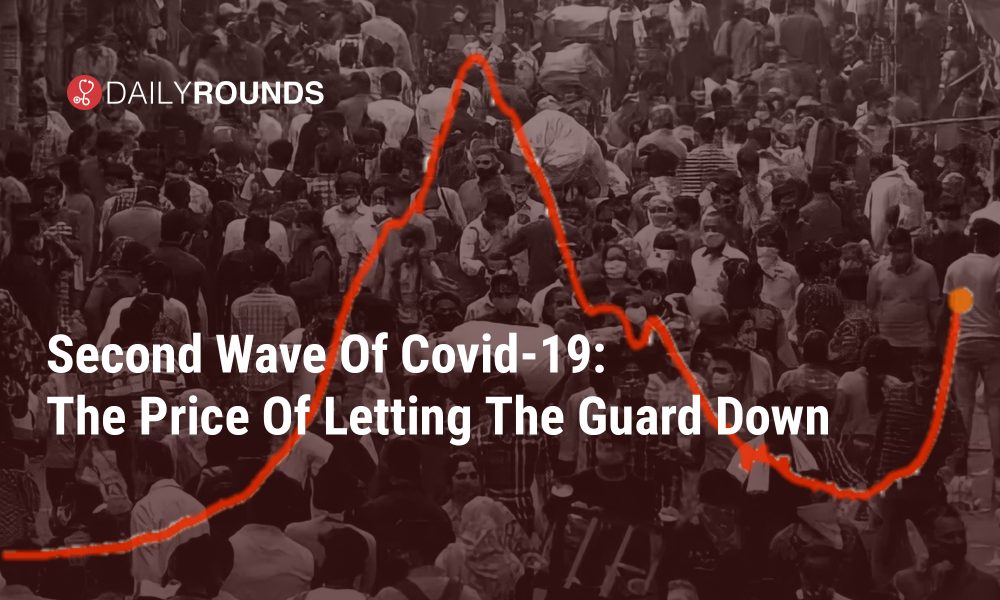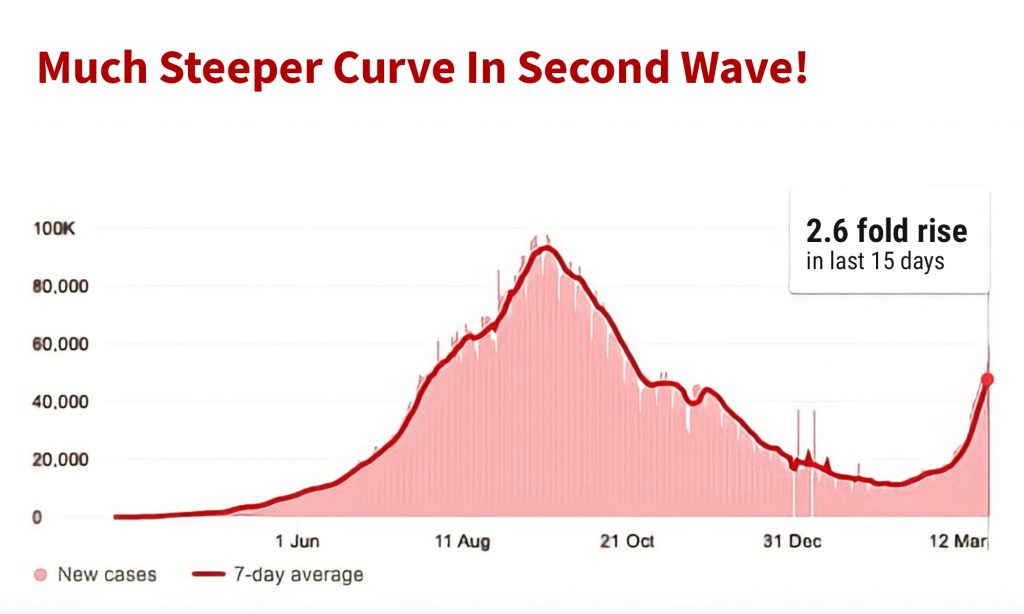
Second Wave Of Covid-19: The Price Of Letting The Guard Down
“One thing is very clear, even when the cases are coming down danger still lurks around the corner, and it’s no time to let down our guard. To relax our vigilance now – having reached so far and at such cost – is surely not an option we should consider.”
This is how we concluded our recent blog on the declining Covid-19 numbers in India. A month later, here we are in the midst of the Covid-19 graph that’s once again sloping upwards. Clearly, we got it wrong somewhere as we were slowly sliding down the curve. The second wave that started mid-February is now undoing months of progress made against the outbreak. How bad is the second wave? Are things as bad as they were during the rise of the first wave? What do the experts say? Here’s a quick look at how the second wave of infection is playing out.
The country recorded 260,000 fresh coronavirus cases last week – one of the worst weekly increases since the pandemic began early last year. The nation also recorded its highest single-day Covid count in over five months on Wednesday with 53,364 people testing positive for the virus. The last time the country had surpassed this tally was on October 23 when 54,350 cases were recorded.

India’s caseload began to dip at the start of 2021 with daily infections falling to less than 20,000 from a peak of over 90,000 in September. But the last few weeks have seen a sharp uptick. While Maharashtra leads the table, several other states – Kerala, Punjab, Karnataka, Gujarat, Tamil Nadu, Haryana, and Madhya Pradesh – are also seeing a rise in cases.
According to a recent statement from the Health Ministry, a total of 771 covid variants, including a ‘double mutant’ strain have been found across 18 Indian states but there is no evidence to link the current surge to these strains. States witnessing higher cases have revealed a different mutation profile but detected variants have been prevalent in the community for the last six to eight months, National Centre for Disease Control director Sujeet Kumar Singh said.
India Reports New 'Double Mutant' Covid Variant Among 771 Variants Found In 18 States #MedTwitter #COVID19India pic.twitter.com/ChFeJ4zi1H
— DailyRounds | Marrow (@DRoundsMarrow) March 26, 2021
Not Just The Mutant Strains, It’s Public Carelessness!
The country’s top public health experts believe that the public’s careless behaviour is causing the surge, not some mutation in the virus. According to the experts, regardless of any mutation, Covid cases will surge only when the public will lower its guard. They say relaxed enforcement measures by the authorities and misleading notions about Covid being in an ‘endemic’ stage are adding to the surge.
Dr. Samiran Panda, a top scientist from the Indian Council of Medical Research (ICMR), said Covid spreads in the community “only when it is invited”. “Old virus or new virus, they all spread through the same route — that is our own carelessness. As soon as we stop following the appropriate behaviour, Covid will come back,” he said, adding that some experts are “misreading” the epidemic.
“General public is being misguided by saying that Covid is now in endemic stage or we are nearing herd immunity. All such analysis gives a false hope that it’s all over now,” he added. Shekhar Mande, Director General at the Council of Scientific and Industrial Research (CSIR), echoed similar observations. “The surge in cases can be attributed to the relaxed, complacent behaviour in the public along with the possibility of the role of mutants,” he said.
Virus Infecting More, Killing Few
K. Srinath Reddy, president of the Public Health Foundation of India (PHFI), said the virus is probably changing its behaviour and is capable of infecting more but killing fewer people. The Covid-19 figures from the last few weeks certainly underlines this observation. He added that there are other reasons due to which the case-fatality rate remains under control, including “more infections among young people, substantial improvement in the Covid management methods and change in the behaviour of the virus which infects more but kills lesser people”.
May Peak In Latter Half Of April
The current second wave of the infection might last up to 100 days counted from February 15, says a research report from SBI. While the report estimates the second wave to result in a total of around 25 lakh Covid-19 cases across the country based on trends till March 23, it predicts that India might reach the peak in the second half of April.
The report, titled ‘Second wave of infections: The beginning of the end?’, also highlights Covid vaccination as a key tool to combat the pandemic, particularly for India which is seeing a surge at a time when vaccination is picking up pace.
No Time For Vaccine Hesitancy
With Covid cases surging, experts suggest there is no time for “vaccine hesitancy” and called on people to take vaccines as and when their turn comes. In light of the present scenario, the Centre has also decided to vaccinate people who are 45 and older from April 1. At present, only citizens who are above 60 and those over 45 with other illnesses are allowed to get the vaccination.
Also, according to sources, the country has put a temporary hold on all major exports of the AstraZeneca coronavirus shot made by the Serum Institute of India (SII), to meet domestic demand as infections rise.
More than 40 million people in India have received at least one dose of a coronavirus vaccine so far, but that’s less than 4% of the country’s population. The government aims to cover 250 million “priority people” by the end of July. Although the pace of vaccination has picked up, experts warn that the target could be missed unless the drive is scaled up further.
The situation is far from normal, in fact, it’s alarming at the moment. The vaccination drive has to be scaled up massively, and test and trace and isolation protocols have to be strengthened across the country to put the breaks on the rising Covid figures. At the end of the day, covid-appropriate behaviour remains the best weapon to fight Covid-19 even in the second wave.
Follow and connect with us on Twitter | Facebook | Instagram
Latest Posts By Kishan Shob
- 02.08.24Diabetes Epidemic in India: The Need for Specialised Diabetology Courses
- 07.12.22The Plan B (School) after MBBS: A guide to pursue MBA after MBBS
- 07.01.22What left us & what lies ahead? Doctors journey towards a ‘new normal’
- 10.09.21What’s Changed In India’s Medical Education Sector In The Last Six Years? [Based on MoHFW Report]
- 10.01.21Ayushman Bharat Digital Health Mission: What It Means For Healthcare Providers And Patients